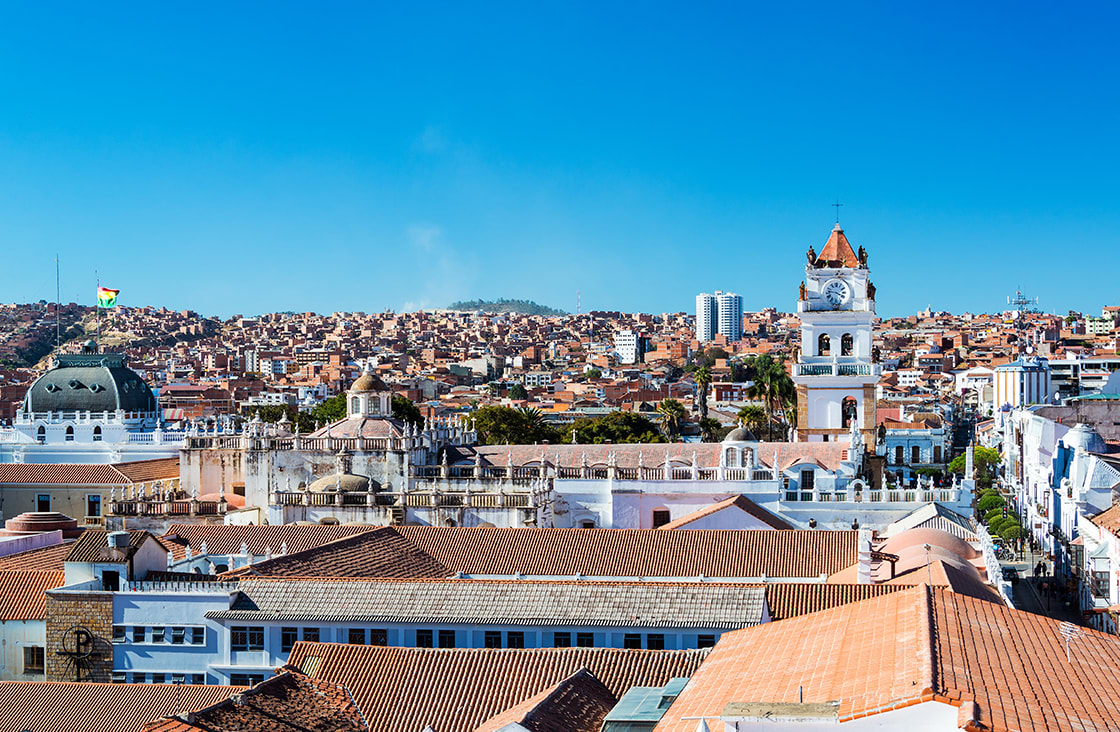
The question of Bolivia’s capital is like the time-old riddle of the chicken and the egg. Fraught with fierce opinion, it’s a nuanced debate that has been the cause of blood shed, violent protests and divisive politics over the centuries. But let’s settle it once and for all – which is the official capital of Bolivia: Sucre or La Paz?
When the Spanish colonized the Americas in the 16th century, they split it into several large territories. Bolivia was at this point part of the territory called Alto Peru along with modern-day Peru and some of Chile, until 1825 when it became independent. With its independence, Sucre was proclaimed Bolivia’s provisional and eventually official capital city, in the Bolivian constitution. Its name honors the revolutionary leader Antonio José de Sucre.
A large part of this decision was the city of Sucre’s proximity to important silver mines – the source of the country’s primary industry at the time. However, the industrial focus gradually shifted from silver to tin, and the tin mines were located near the city of La Paz. Generally, the silver mine owners lived in Sucre, while the tin mine owners lived in La Paz. So La Paz began to surpass Sucre in economical importance, and its population grew.
Whiz forward to the end of the 19th century, and the Federal Revolution of 1899. This was a brief civil war between the ruling Conservative party (which the silver miners traditionally supported) and the Liberal party (backed by the tin miners). As they struggled for political power, at the heart of this civil war was the debate over which city should be the capital. When the Liberals won, the two parties reached a compromise.
La Paz was established as the seat of government for the legislative and executive branches, while Sucre retained the seat of the judicial branch of the Bolivian government. To this day, Sucre remains the only official capital of Bolivia, but La Paz is considered by many as the de facto capital.
There is still much conflict over the issue of the two capitals, and many see La Paz as the true heart of the country. It’s home to the foreign embassies, government ministries and central bank (not to mention the president!) and is now four times as large as its counterpart.
La Paz is the third most populous city in Bolivia (after Santa Cruz and El Alto) with around 835 thousand people. It’s only 68 km (42 mi) away from the spectacular Lake Titicaca and occupies a magnificent canyon carved out by the Choqueyapu River.
Expect an urban jungle, with tumbling terracotta roofs and frantic sprawling markets, and streets heaving with energy, fascinating history and unique culture. Andean crafts are sold by authentic market vendors and there’s a network of cheap cable cars that stretch over the city giving incredible views. If you are planning to visit La Paz, you should be prepared for (literally) breathtaking altitudes – it perches at 3,650 m (11,975 ft) above sea level, making it the highest capital city in the world.

Panoramic View of Sucre, Bolivia
While La Paz embodies uproar and excitement, Sucre stands for peace and tranquility, perfect for vacations if calm is what you are looking for. The climate is mild and the people are relaxed and warm. Home to around 300 thousand people, Sucre is located in Bolivia’s Central Highlands, and is much older than La Paz, first established back in 1538.
It’s known as the most beautiful city in Bolivia and with a UNESCO World Heritage listed city center it’s not hard to see why. Sucre is famous for its whitewash buildings (giving its alternative name la ciudad blanca), picturesque rooftops and well-preserved colonial architecture. Many who travel to Sucre never leave, partly because it’s one of the cheapest places to live and one of the safest cities in South America. It’s often used as a base from which to get to Bolivia’s famous salt flats, Salar de Uyuni.
At the end of the day, comparing the two cities is a near impossible task as both La Paz and Sucre have completely different qualities. The debate over which is the true capital will no doubt continue for many years to come – the only thing for it is to visit them both and decide for yourself! To book an unforgettable journey in Bolivia please contact us by sending us an enquiry or calling us at 1-888-215-3555.
While Rainforest Cruises aim to provide accurate and up-to-date information, we make no representations as to the accuracy or completeness of any information herein or found by following any link on this site. Rainforest Cruises cannot and will not accept responsibility for any omissions or inaccuracies, or for any consequences arising therefrom, including any losses, injuries, or damages resulting from the display or use of this information.




